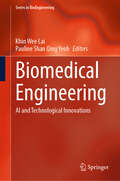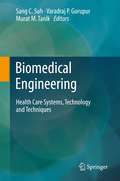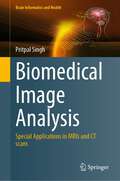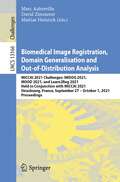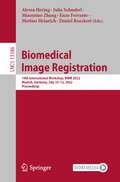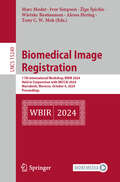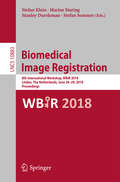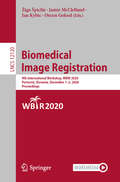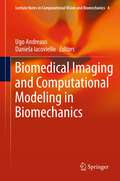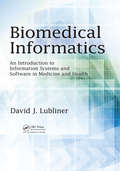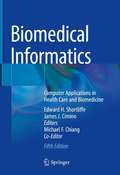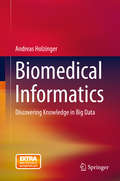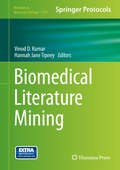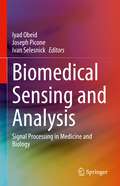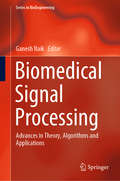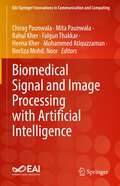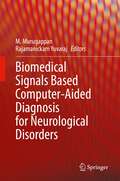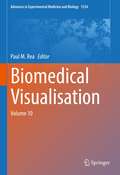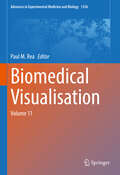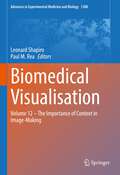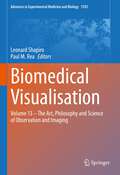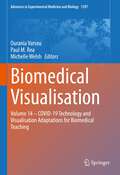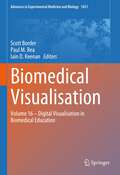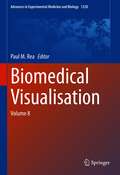- Table View
- List View
Biomedical Engineering: AI and Technological Innovations (Series in BioEngineering)
by Khin Wee Lai Pauline Shan Qing YeohThis book brings together contributions from leading experts in the field, each addressing a critical area where AI and technology are making significant impacts. The chapters encompass a wide range of topics, from the application of machine learning in cancer grading and maternal health monitoring to the development of innovative wearable devices and advanced diagnostic tools. The book not only underscores the transformative potential of AI and technology in biomedical; but also serves as a vital resource for researchers, practitioners, and students. By showcasing the latest research and innovations, this book aims to inspire continued exploration and development in this dynamic and rapidly evolving field.
Biomedical Engineering: Health Care Systems, Technology and Techniques
by Sang C. Suh Varadraj Gurupur Murat M. TanikBiomedical Engineering: Health Care Systems, Technology and Techniques is an edited volume with contributions from world experts. It provides readers with unique contributions related to current research and future healthcare systems. Practitioners and researchers focused on computer science, bioinformatics, engineering and medicine will find this book a valuable reference.
Biomedical Image Analysis
by Aly A. FaragIdeal for classroom use and self-study, this book explains the implementation of the most effective modern methods in image analysis, covering segmentation, registration and visualisation, and focusing on the key theories, algorithms and applications that have emerged from recent progress in computer vision, imaging and computational biomedical science. Structured around five core building blocks - signals, systems, image formation and modality; stochastic models; computational geometry; level set methods; and tools and CAD models - it provides a solid overview of the field. Mathematical and statistical topics are presented in a straightforward manner, enabling the reader to gain a deep understanding of the subject without becoming entangled in mathematical complexities. Theory is connected to practical examples in x-ray, ultrasound, nuclear medicine, MRI and CT imaging, removing the abstract nature of the models and assisting reader understanding, whilst computer simulations, online course slides and a solution manual provide a complete instructor package.
Biomedical Image Analysis: Special Applications in MRIs and CT scans (Brain Informatics and Health)
by Pritpal SinghThis book provides an in-depth study of biomedical image analysis. Itreviews and summarizes previous research work in biomedical image analysis andalso provides a brief introduction to other computation techniques, such asfuzzy sets, neutrosophic sets, clustering algorithm and fast forward quantumoptimization algorithm, focusing on how these techniques can be integrated intodifferent phases of the biomedical image analysis. In particular, this bookdescribes novel methods resulting from the fuzzy sets, neutrosophic sets,clustering algorithm and fast forward quantum optimization algorithm. It alsodemonstrates how a new quantum-clustering based model can be successfullyapplied in the context of clustering the COVID-19 CT scans. Thanks to itseasy-to-read style and the clear explanations of the models, the book can beused as a concise yet comprehensive reference guide to biomedical imageanalysis, and will be valuable not only for graduate students, but also forresearchers and professionals working for academic, business and governmentinstitutes and medical colleges.
Biomedical Image Registration, Domain Generalisation and Out-of-Distribution Analysis: MICCAI 2021 Challenges: MIDOG 2021, MOOD 2021, and Learn2Reg 2021, Held in Conjunction with MICCAI 2021, Strasbourg, France, September 27–October 1, 2021, Proceedings (Lecture Notes in Computer Science #13166)
by Marc Aubreville David Zimmerer Mattias HeinrichThis book constitutes three challenges that were held in conjunction with the 24th International Conference on Medical Image Computing and Computer-Assisted Intervention, MICCAI 2021, which was planned to take place in Strasbourg, France but changed to an online event due to the COVID-19 pandemic. The peer-reviewed 18 long and 9 short papers included in this volume stem from the following three biomedical image analysis challenges: Mitosis Domain Generalization Challenge (MIDOG 2021), Medical Out-of-Distribution Analysis Challenge (MOOD 2021), and Learn2Reg (L2R 2021). The challenges share the need for developing and fairly evaluating algorithms that increase accuracy, reproducibility and efficiency of automated image analysis in clinically relevant applications.
Biomedical Image Registration: 10th International Workshop, WBIR 2022, Munich, Germany, July 10–12, 2022, Proceedings (Lecture Notes in Computer Science #13386)
by Daniel Rueckert Enzo Ferrante Julia Schnabel Mattias Heinrich Alessa Hering Miaomiao ZhangThis book constitutes the refereed proceedings of the 10th International Workshop on Biomedical Image Registration, WBIR 2020, which was supposed to be held in Munich, Germany, in July 2022.The 11 full and poster papers together with 17 short papers included in this volume were carefully reviewed and selected from 32 submitted papers. The papers are organized in the following topical sections: optimization, deep learning architectures, neuroimaging, diffeomorphisms, uncertainty, topology and metrics.
Biomedical Image Registration: 11th International Workshop, WBIR 2024, Held in Conjunction with MICCAI 2024, Marrakesh, Morocco, October 6, 2024, Proceedings (Lecture Notes in Computer Science #15249)
by Marc Modat Ivor Simpson Žiga Špiclin Alessa Hering Wietske Bastiaansen Tony C. W. MokThis book constitutes the refereed proceedings of the 11th International Workshop on Biomedical Image Registration, WBIR 2024, held in conjunction with the 27th International conference on Medical Image Computing and Computer Assisted Intervention, MICCAI 2024, in Marrakesh, Morocco in October 2024. The 28 full papers presented in this book were carefully reviewed and selected from 32 submissions. These papers have been categorized under the following topical sections: Architectures; Robustness; Atlas/ Fusion; Feature/ Similarity Learning & Efficiency.
Biomedical Image Registration: 8th International Workshop, WBIR 2018, Leiden, The Netherlands, June 28-29, 2018, Proceedings (Lecture Notes in Computer Science #10883)
by Stefan Klein Stanley Durrleman Stefan Sommer Marius StaringThis book constitutes the refereed proceedings of the 8th International Workshop on Biomedical Image Registration, WBIR 2018, held in Leiden, The Netherlands, in June 2018. The 11 full and poster papers included in this volume were carefully reviewed and selected from 17 submitted papers. The papers are organized in the following topical sections: Sliding Motion, Groupwise Registration, Acceleration, and Applications and Evaluation.
Biomedical Image Registration: 9th International Workshop, WBIR 2020, Portorož, Slovenia, December 1–2, 2020, Proceedings (Lecture Notes in Computer Science #12120)
by Orcun Goksel Žiga Špiclin Jamie McClelland Jan KybicThis book constitutes the refereed proceedings of the 9th International Workshop on Biomedical Image Registration, WBIR 2020, which was supposed to be held in Portorož, Slovenia, in June 2020. The conference was postponed until December 2020 due to the COVID-19 pandemic. The 16 full and poster papers included in this volume were carefully reviewed and selected from 22 submitted papers. The papers are organized in the following topical sections: Registration initialization and acceleration, interventional registration, landmark based registration, multi-channel registration, and sliding motion.
Biomedical Imaging and Computational Modeling in Biomechanics (Lecture Notes in Computational Vision and Biomechanics #4)
by Daniela Iacoviello Ugo AndreausThis book collects the state-of-art and new trends in image analysis and biomechanics. It covers a wide field of scientific and cultural topics, ranging from remodeling of bone tissue under the mechanical stimulus up to optimizing the performance of sports equipment, through the patient-specific modeling in orthopedics, microtomography and its application in oral and implant research, computational modeling in the field of hip prostheses, image based model development and analysis of the human knee joint, kinematics of the hip joint, micro-scale analysis of compositional and mechanical properties of dentin, automated techniques for cervical cell image analysis, and biomedical imaging and computational modeling in cardiovascular disease. The book will be of interest to researchers, Ph.D students, and graduate students with multidisciplinary interests related to image analysis and understanding, medical imaging, biomechanics, simulation and modeling, experimental analysis
Biomedical Informatics: An Introduction to Information Systems and Software in Medicine and Health
by David J. LublinerThis complete medical informatics textbook begins by reviewing the IT aspects of informatics, including systems architecture, electronic health records, interoperability, privacy and security, cloud computing, mobile healthcare, imaging, capturing data, and design issues. Next, it provides case studies that illustrate the roll out of EHRs in hospitals. The third section incorporates four anatomy and physiology lectures that focus on the physiological basis behind data captured in EHR medical records. The book includes links to documents and standards sources so students can explore each idea discussed in more detail.
Biomedical Informatics: Computer Applications in Health Care and Biomedicine
by Michael F. ChiangThis 5th edition of this essential textbook continues to meet the growing demand of practitioners, researchers, educators, and students for a comprehensive introduction to key topics in biomedical informatics and the underlying scientific issues that sit at the intersection of biomedical science, patient care, public health and information technology (IT). Emphasizing the conceptual basis of the field rather than technical details, it provides the tools for study required for readers to comprehend, assess, and utilize biomedical informatics and health IT. It focuses on practical examples, a guide to additional literature, chapter summaries and a comprehensive glossary with concise definitions of recurring terms for self-study or classroom use.Biomedical Informatics: Computer Applications in Health Care and Biomedicine reflects the remarkable changes in both computing and health care that continue to occur and the exploding interest in the role that IT must play in care coordination and the melding of genomics with innovations in clinical practice and treatment. New and heavily revised chapters have been introduced on human-computer interaction, mHealth, personal health informatics and precision medicine, while the structure of the other chapters has undergone extensive revisions to reflect the developments in the area. The organization and philosophy remain unchanged, focusing on the science of information and knowledge management, and the role of computers and communications in modern biomedical research, health and health care.
Biomedical Informatics: Discovering Knowledge in Big Data (Lecture Notes in Computer Science #8401)
by Andreas HolzingerThis book provides a broad overview of the topic Bioinformatics with focus on data, information and knowledge. From data acquisition and storage to visualization, ranging through privacy, regulatory and other practical and theoretical topics, the author touches several fundamental aspects of the innovative interface between Medical and Technology domains that is Biomedical Informatics. Each chapter starts by providing a useful inventory of definitions and commonly used acronyms for each topic and throughout the text, the reader finds several real-world examples, methodologies and ideas that complement the technical and theoretical background This new edition includes new sections at the end of each chapter, called "future outlook and research avenues," providing pointers to future challenges. At the beginning of each chapter a new section called "key problems", has been added, where the author discusses possible traps and unsolvable or major problems
Biomedical Literature Mining (Methods in Molecular Biology #1159)
by Vinod D. Kumar Hannah Jane TipneyBiomedical Literature Mining, discusses the multiple facets of modern biomedical literature mining and its many applications in genomics and systems biology. The volume is divided into three sections focusing on information retrieval, integrated text-mining approaches and domain-specific mining methods. Written in the highly successful Methods in Molecular Biology series format, chapters include introductions to their respective topics, lists of the necessary materials and reagents, step-by-step, readily reproducible laboratory protocols and key tips on troubleshooting and avoiding known pitfalls. Authoritative and practical, Biomedical Literature Mining is designed as a useful bioinformatics resource in biomedical literature text mining for both those long experienced in or entirely new to, the field.
Biomedical Sensing and Analysis: Signal Processing in Medicine and Biology
by Iyad Obeid Ivan Selesnick Joseph PiconeThis book provides an interdisciplinary look at emerging trends in signal processing and biomedicine found at the intersection of healthcare, engineering, and computer science. Bringing together expanded versions of selected papers presented at the 2020 IEEE Signal Processing in Medicine and Biology Symposium (IEEE SPMB), it examines the vital role signal processing plays in enabling a new generation of technology based on big data and looks at applications ranging from medical electronics to data mining of electronic medical records. Topics covered include analysis of medical images, machine learning, biomedical nanosensors, wireless technologies, and instrumentation and electrical stimulation. Biomedical Sensing and Analysis: Signal Processing in Medicine and Biology presents tutorials and examples of successful applications, and will appeal to a wide range of professionals, researchers, and students interested in applications of signal processing, medicine, and biology.Presents an interdisciplinary look at research trends in signal processing and biomedicine;Promotes collaboration between healthcare practitioners and signal processing researchers;Includes tutorials and examples of successful applications.
Biomedical Signal Processing: Advances in Theory, Algorithms and Applications (Series in BioEngineering)
by Ganesh NaikThis book reports on the latest advances in the study of biomedical signal processing, and discusses in detail a number of open problems concerning clinical, biomedical and neural signals. It methodically collects and presents in a unified form the research findings previously scattered throughout various scientific journals and conference proceedings. In addition, the chapters are self-contained and can be read independently. Accordingly, the book will be of interest to university researchers, R&D engineers and graduate students who wish to learn the core principles of biomedical signal analysis, algorithms, and applications, while also offering a valuable reference work for biomedical engineers and clinicians who wish to learn more about the theory and recent applications of neural engineering and biomedical signal processing.
Biomedical Signal and Image Processing with Artificial Intelligence (EAI/Springer Innovations in Communication and Computing)
by Mohammed Atiquzzaman Rahul Kher Falgun Thakkar Chirag Paunwala Heena Kher Mita Paunwala Norliza Mohd. NoorThis book focuses on advanced techniques used for feature extraction, analysis, recognition, and classification in the area of biomedical signal and image processing. Contributions cover all aspects of artificial intelligence, machine learning, and deep learning in the field of biomedical signal and image processing using novel and unexplored techniques and methodologies. The book covers recent developments in both medical images and signals analyzed by artificial intelligence techniques. The authors also cover topics related to development based artificial intelligence, which includes machine learning, neural networks, and deep learning. This book will provide a platform for researchers who are working in the area of artificial intelligence for biomedical applications.Provides insights into medical signal and image analysis using artificial intelligence;Includes novel and recent trends of decision support system for medical research;Outlines employment of evolutionary algorithms for biomedical data, big data analysis for medical databases, and reliability, opportunities, and challenges in clinical data.
Biomedical Signals Based Computer-Aided Diagnosis for Neurological Disorders
by M. Murugappan Rajamanickam YuvarajBiomedical signals provide unprecedented insight into abnormal or anomalous neurological conditions. The computer-aided diagnosis (CAD) system plays a key role in detecting neurological abnormalities and improving diagnosis and treatment consistency in medicine. This book covers different aspects of biomedical signals-based systems used in the automatic detection/identification of neurological disorders. Several biomedical signals are introduced and analyzed, including electroencephalogram (EEG), electrocardiogram (ECG), heart rate (HR), magnetoencephalogram (MEG), and electromyogram (EMG). It explains the role of the CAD system in processing biomedical signals and the application to neurological disorder diagnosis. The book provides the basics of biomedical signal processing, optimization methods, and machine learning/deep learning techniques used in designing CAD systems for neurological disorders.
Biomedical Visualisation: Volume 10 (Advances in Experimental Medicine and Biology #1334)
by Paul M. ReaThis edited book explores the use of technology to enable us to visualise the life sciences in a more meaningful and engaging way. It will enable those interested in visualisation techniques to gain a better understanding of the applications that can be used in visualisation, imaging and analysis, education, engagement and training. The reader will also be able to learn about the use of visualisation techniques and technologies for the historical and forensic settings.The reader will be able to explore the utilisation of technologies from a number of fields to enable an engaging and meaningful visual representation of the biomedical sciences. The chapters presented in this volume cover such a diverse range of topics, with something for everyone. We present here chapters on technology enhanced learning in neuroanatomy; 3D printing and surgical planning; changes in higher education utilising technology, decolonising the curriculum and visual representations of the human body in education. We also showcase how not to use protective personal equipment inspired by the pandemic; anatomical and historical visualisation of obstetrics and gynaecology; 3D modelling of carpal bones and augmented reality for arachnid phobias for public engagement. In addition, we also present face modelling for surgical education in a multidisciplinary setting, military medical museum 3D digitising of historical pathology specimens and finally computational fluid dynamics.
Biomedical Visualisation: Volume 11 (Advances in Experimental Medicine and Biology #1356)
by Paul M. ReaThis edited book explores the use of technology to enable us to visualise the life sciences in a more meaningful and engaging way. It will enable those interested in visualisation techniques to gain a better understanding of the applications that can be used in visualisation, imaging and analysis, education, engagement and training. The reader will also be able to learn about the use of visualisation techniques and technologies for the historical and forensic settings.The chapters presented in this volume cover such a diverse range of topics, with something for everyone. We present here chapters on 3D visualising novel stent grafts to aid treatment of aortic aneuryms; confocal microscopy constructed vascular models in patient education; 3D patient specific virtual reconstructions in surgery; virtual reality in upper limb rehabilitation in patients with multiple sclerosis and virtual clinical wards. In addition, we present chapters in artificial intelligence in ultrasound guided regional anaesthesia; carpal tunnel release visualisation techniques; visualising for embryology education and artificial intelligence data on bone mechanics. Finally we conclude with chapters on visualising patient communication in a general practice setting; digital facial depictions of people from the past; instructor made cadaveric videos, novel cadaveric techniques for enhancing visualisation of the human body and finally interactive educational videos and screencasts. This book explores the use of technologies from a range of fields to provide engaging and meaningful visual representations of the biomedical sciences. It is therefore an interesting read for researchers, developers and educators who want to learn how visualisation techniques can be used successfully for a variety of purposes, such as educating students or training staff, interacting with patients and biomedical procedures in general.
Biomedical Visualisation: Volume 12 ‒ The Importance of Context in Image-Making (Advances in Experimental Medicine and Biology #1388)
by Leonard Shapiro Paul M. ReaThis image-rich book explores the practice as well as the theory of visual representation and presents us with the importance of designing appropriate images for communication to specific target audiences. This includes the appropriate choice of high-tech digital or low-tech analogue technologies in image-making for communication within the medical education, biological research and community health contexts. We hear from medical students about the value of using clay modelling in their understanding of anatomy, from educators and curriculum designers about visual affordances in medical education and from a community-driven project in South Africa about their innovative use of locally designed images and culture-specific narratives for communicating important health information to marginalised communities. A chapter explores the evolution of scientific visualisation and representation of big data to a variety of audiences, and another presents the innovative 3D construction of internal cellular structures from microscopic 2D slices. As we embrace blended learning in anatomy education, a timely chapter prompts us to think further about and contribute to the ongoing discourse around important ethical considerations in the use and sharing of digital images of body donors. This book will appeal to educators, medical illustrators, curriculum designers, post-graduate students, community health practitioners and biomedical researchers.
Biomedical Visualisation: Volume 13 – The Art, Philosophy and Science of Observation and Imaging (Advances in Experimental Medicine and Biology #1392)
by Leonard Shapiro Paul M. ReaThis book brings together current advances in high-technology visualisation and the age-old but science-adapted practice of drawing for improved observation in medical education and surgical planning and practice. We begin this book with a chapter reviewing the history of confusion around visualisation, observation and theory, outlining the implications for medical imaging. The authors consider the shifting influence of various schools of philosophy, and the changing agency of technology over time. We then follow with chapters on the practical application of visualisation and observation, including emerging imaging techniques in anatomy for teaching, research and clinical practice - innovation in the mapping of orthopaedic fractures for optimal orthopaedic surgical guidance - placental morphology and morphometry as a prerequisite for future pathological investigations - visualising the dural venous sinuses using volume tracing. Two chapters explore the use and benefit of drawing in medical education and surgical planning. It is worth noting that experienced surgeons and artists employ a common set of techniques as part of their work which involves both close observation and the development of fine motor skills and sensitive tool use.An in-depth look at police identikit construction from memory by eyewitnesses to crimes, outlines how an individual’s memory of a suspect’s facial features are rendered visible as a composite image.This book offers anatomy educators and clinicians an overview of the history and philosophy of medical observation and imaging, as well as an overview of contemporary imaging technologies for anatomy education and clinical practice. In addition, we offer anatomy educators and clinicians a detailed overview of drawing practices for the improvement of anatomical observation and surgical planning. Forensic psychologists and law enforcement personnel will not only benefit from a chapter dedicated to the construction of facial composites, but also from chapters on drawing and observation.
Biomedical Visualisation: Volume 14 ‒ COVID-19 Technology and Visualisation Adaptations for Biomedical Teaching (Advances in Experimental Medicine and Biology #1397)
by Paul M. Rea Ourania Varsou Michelle WelshThis book focuses on the challenges to biomedical education posed by the lockdowns and restrictions to on campus teaching brought about by the COVID-19 pandemic and highlights the tools and digital visualization technologies that have been successfully developed and used for remote teaching. Biomedical education for science, medical, dental and allied health professionals relies on teaching visual and tactile knowledge using practice-based approaches. This has been delivered for decades via on-campus lectures, workshops and laboratories, teaching practical skills as well as fundamental knowledge and understanding. However, the arrival of the COVID-19 pandemic meant that education across the globe had to pivot very quickly to be able to deliver these skills and knowledge in a predominantly online environment. This brought with it many challenges, as Higher Education staff, had to adapt to deliver these visual subjects remotely. This book addresses the challenges and solutions faced by Higher Education staff in teaching visual content in distance education. Chapters include literature reviews, original research, and pedagogical reflections for a wide range of biomedical subjects, degrees such as medicine, dentistry and veterinary sciences with examples from undergraduate and postgraduate settings. The goal of the book is to provide a compendium of expertise based on evidence gathered during the COVID-19 pandemic, as well as reflections on the challenges and lessons learned from this dramatic shift in teaching. It also presents new examples of best practices that have emerged from this experience to ensure that they are not lost as we return to on-campus learning in a new era of biomedical teaching. This book will be of interest to anyone looking for a helpful reference point when designing online or blended teaching for visual practice-based subjects.
Biomedical Visualisation: Volume 16 ‒ Digital Visualisation in Biomedical Education (Advances in Experimental Medicine and Biology #1421)
by Paul M. Rea Scott Border Iain D. KeenanWhen studying medicine, healthcare, and medical sciences disciplines, learners are frequently required to visualise and understand complex three-dimensional concepts. Consequently, it is important that appropriate modalities are used to support their learning. Recently, educators have turned to new and existing digital visualisation approaches when adapting to pandemic-era challenges and when delivering blended post-pandemic teaching.This book focuses on a range of key themes in anatomical and clinically oriented education that can be enhanced through visual understanding of the spatial three-dimensional arrangement and structure of human patients.The opening chapters describe important digital adaptations for the dissemination of biomedical education to the public and to learners. These topics are followed by reviews and reports of specific modern visualisation technologies for supporting anatomical, biomedical sciences, and clinical education. Examples include 3D printing, 3D digital models, virtual histology, extended reality, and digital simulation. This book will be of interest to academics, educators, and communities aiming to modernise and innovate their teaching. Additionally, this book will appeal to clinical teachers and allied healthcare professionals who are responsible for the training and development of colleagues, and those wishing to communicate effectively to a range of audiences using multimodal digital approaches.
Biomedical Visualisation: Volume 8 (Advances in Experimental Medicine and Biology #1260)
by Paul M. ReaThis edited book explores the use of technology to enable us to visualise the life sciences in a more meaningful and engaging way. It will enable those interested in visualisation techniques to gain a better understanding of the applications that can be used in visualisation, imaging and analysis, education, engagement and training.The reader will be able to explore the utilisation of technologies from a number of fields to enable an engaging and meaningful visual representation of the biomedical sciences, with a focus in this volume related to anatomy, and clinically applied scenarios. The first six chapters in this volume show the wide variety of tools and methodologies that digital technologies and visualisation techniques can be utilised and adopted in the educational setting. This ranges from body painting, clinical neuroanatomy, histology and veterinary anatomy through to real time visualisations and the uses of digital and social media for anatomical education. The last four chapters represent the diversity that technology has to be able to use differing realities and 3D capture in medical visualisation, and how remote visualisation techniques have developed. Finally, it concludes with an analysis of image overlays and augmented reality and what the wider literature says about this rapidly evolving field.
